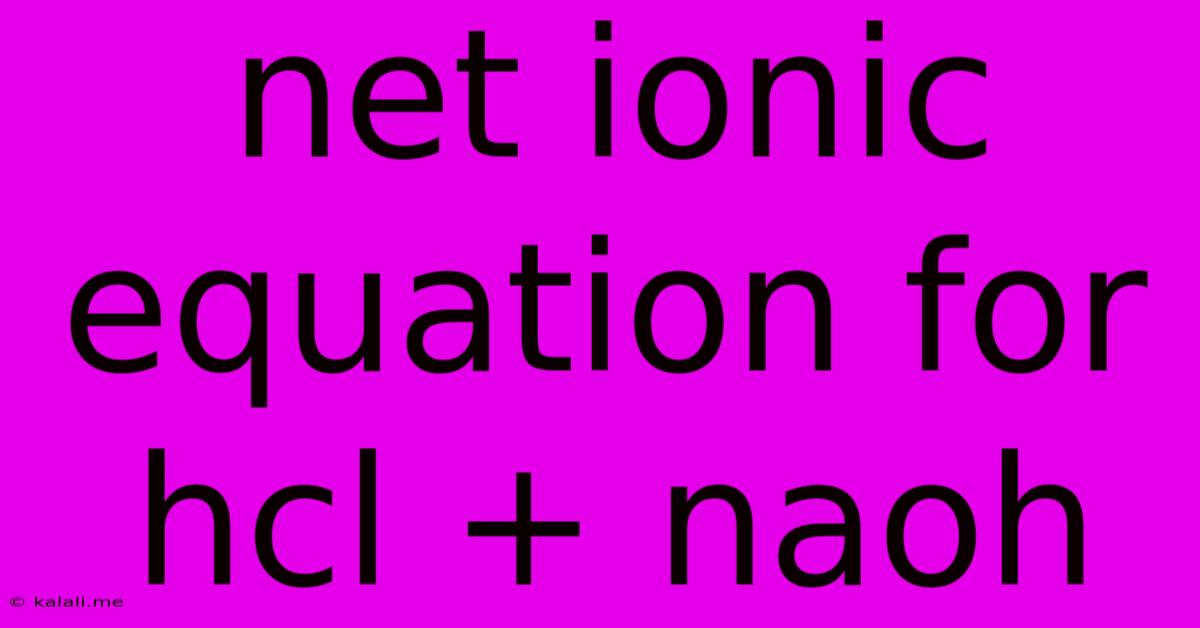Net Ionic Equation For Hcl + Naoh
Kalali
May 09, 2025 · 3 min read

Table of Contents
Net Ionic Equation for HCl + NaOH: A Comprehensive Guide
The reaction between hydrochloric acid (HCl) and sodium hydroxide (NaOH) is a classic example of a neutralization reaction, a type of double displacement reaction where an acid and a base react to form water and a salt. Understanding how to write the net ionic equation for this reaction is crucial for grasping fundamental concepts in chemistry. This article will provide a step-by-step guide, explaining the process and the underlying principles. This will also cover related concepts such as spectator ions and complete ionic equations.
Understanding the Reaction:
Hydrochloric acid (HCl) is a strong acid, meaning it completely dissociates in water. Sodium hydroxide (NaOH) is a strong base, also completely dissociating in water. When these two solutions are mixed, a neutralization reaction occurs, producing water (H₂O) and sodium chloride (NaCl), a salt. The balanced molecular equation is:
HCl(aq) + NaOH(aq) → NaCl(aq) + H₂O(l)
Writing the Complete Ionic Equation:
To write the complete ionic equation, we need to break down all the strong electrolytes (compounds that completely dissociate into ions in water) into their constituent ions. Water, being a weak electrolyte, remains as a molecule.
The complete ionic equation is:
H⁺(aq) + Cl⁻(aq) + Na⁺(aq) + OH⁻(aq) → Na⁺(aq) + Cl⁻(aq) + H₂O(l)
Identifying and Removing Spectator Ions:
Spectator ions are ions that appear on both sides of the complete ionic equation and do not participate in the actual reaction. In this case, Na⁺(aq) and Cl⁻(aq) are spectator ions. They are present before and after the reaction, essentially unchanged.
To obtain the net ionic equation, we remove the spectator ions from the complete ionic equation.
Writing the Net Ionic Equation:
After removing the spectator ions (Na⁺ and Cl⁻), we are left with the net ionic equation, which represents the essential chemical change occurring in the reaction:
H⁺(aq) + OH⁻(aq) → H₂O(l)
This equation shows the formation of water from hydrogen ions and hydroxide ions, the core of the neutralization reaction between a strong acid and a strong base. This net ionic equation is the same for all strong acid-strong base neutralization reactions.
Key Concepts Revisited:
- Strong Electrolytes: These compounds completely dissociate into ions when dissolved in water. Examples include strong acids (HCl, HNO₃, H₂SO₄), strong bases (NaOH, KOH, Ca(OH)₂), and many soluble salts.
- Weak Electrolytes: These compounds only partially dissociate into ions in water. Water itself is a weak electrolyte.
- Spectator Ions: Ions that are present in solution but do not participate in the chemical reaction.
- Net Ionic Equation: An equation that shows only the species that are directly involved in the chemical reaction, excluding spectator ions.
Understanding the difference between molecular, complete ionic, and net ionic equations is vital for a thorough understanding of chemical reactions in aqueous solutions. The net ionic equation for HCl + NaOH provides a clear and concise representation of the fundamental chemical process involved in this common neutralization reaction.
Latest Posts
Latest Posts
-
127 Out Of 150 As A Percentage
May 09, 2025
-
How Does The Respiratory System Work With The Digestive
May 09, 2025
-
Is 41 A Prime Number Or A Composite Number
May 09, 2025
-
What Is 76 Of An Hour
May 09, 2025
-
How Long Is 55cm In Inches
May 09, 2025
Related Post
Thank you for visiting our website which covers about Net Ionic Equation For Hcl + Naoh . We hope the information provided has been useful to you. Feel free to contact us if you have any questions or need further assistance. See you next time and don't miss to bookmark.